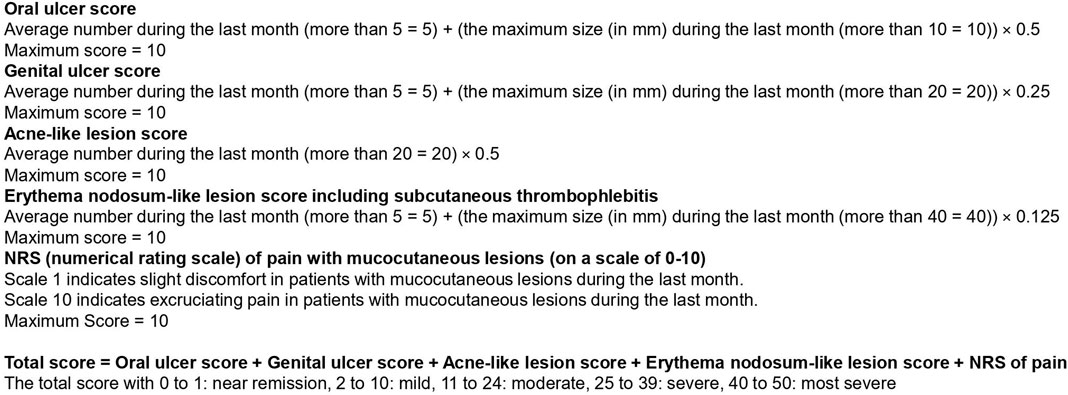- 1Division of Dermatology, Tohoku Medical and Pharmaceutical University, Sendai, Japan
- 2Department of Dermatology, Saitama Medical University, Saitama, Japan
- 3Department of Stem Cell and Immune Regulation, Yokohama City University, Graduate School of Medicine, Yokohama, Japan
- 4Department of Allgery and Rheumatology, Nippon Medical School Musashi Kosugi Hospital, Kawasaki, Japan
Dear Editor,
Behçet’s disease (BD) is an inflammatory multi-system disorder causing recurrent oral, genital ulcers, skin lesions including acne-like eruptions and erythema nodosum-like lesions, and uveitis, in addition to neurological and gastrointestinal manifestations. However, no specific biochemical or serological marker is currently present for the evaluation of disease activity in BD [1, 2]. In addition, no standardized mucocutaneous activity index is currently present to monitor clinical manifestations with mucocutaneous lesions [3, 4]. The present manuscript outlines a mucocutaneous activity index we developed (Figure 1).
The mucocutaneous activity index consists of five elements [oral ulcer score, genital ulcer score, acne-like lesion score, erythema nodosum-like lesion score, and numerical rating scale (NRS) of pain with mucocutaneous lesions]. Each lesion type is scored based on the count and size of the lesions over the last 4 weeks. To determine the oral ulcer score and genital ulcer score, doctors ask a patient how many ulcers and what size ulcers they had in their mouth over the last 4 weeks. To determine the acne-like skin lesion score, doctors ask a patient how many acne or acne-like skin lesions they had in their mouth over the last 4 weeks. To determine the erythema nodosum-like lesion score, doctors ask a patient how many erythema nodosum-like lesions and what size they had in their mouth over the last 4 weeks. To measure the NRS of pain associated with the mucocutaneous lesions, doctors ask a patient how much pain they feel associated with their conditions in their mouth over the last 4 weeks.
The clinical data of the BD patients from our dermatology department between June and July 2023 were scored according to the mucocutaneous activity index (Supplementary Table S1) to confirm whether the index could reflect clinical conditions. Nine patients were seen in our division, all of whom were female and had a median age of 42.6 years. We determined that there was moderate disease activity in six patients and mild disease activity in three patients. A 10-point NRS is a simple rating system that is commonly used globally in oral medicine to assess various diseases, such as atopic dermatitis. We found significantly positive correlations between the total score and the NRS of pain in the nine patients with BD (r = 0.885, p = 0.0015) (Supplementary Figure S1). We found significantly positive correlations between the total score and numbers of oral ulcer in them (p = 0.0071). Similarly, positive significant correlations were observed for the total score and size of oral ulcer in them (p = 0.0192). Based on this correlation, we suggest that the mucocutaneous activity index could play some role in helping the decision-making process for treatment strategies in BD patients with mucocutaneous lesions. In conclusion, we here propose a comprehensive mucocutaneous activity index for Behçet’s disease that is useful for daily practice and evaluating therapeutic efficacy in clinical trials. We are currently validating the index in a large-scale study using the Japanese Behçet’s disease registry.
Data availability statement
The raw data supporting the conclusions of this article will be made available by the authors, without undue reservation.
Ethics statement
This study was approved by the Tohoku Medical and Pharmaceutical University Ethics Committee, and informed consent was obtained from all patients (No. 2021-2-045).
Author contributions
All authors listed have made a substantial, direct, and intellectual contribution to the work and approved it for publication.
Funding
This study was supported by a grant for the Behçet’s Disease Research Committee from the Japanese Ministry of Health, Labour and Welfare (Grant no. 23FC0201).
Conflict of interest
The authors declare that the research was conducted in the absence of any commercial or financial relationships that could be construed as a potential conflict of interest.
Supplementary material
The Supplementary Material for this article can be found online at: https://www.frontierspartnerships.org/articles/10.3389/jcia.2024.12652/full#supplementary-material
SUPPLEMENTARY TABLE S1 | Mucocutaneous activity index in Behçet’s disease.
SUPPLEMENTARY FIGURE S1 | We found significantly positive correlations between total score (X-axis) and NRS, of pain (Y-axis) in these patients (r = 0.885, p = 0.0015).
References
1. Lawton, G, Bhakta, BB, Chamberlain, MA, and Tennant, A. The Behçet’s disease activity index. Rheumatology (2004) 43(1):73–8. doi:10.1093/rheumatology/keg453
2. Bhakta, BB, Brennan, P, James, TE, Chamberlain, MA, Noble, BA, and Silman, AJ. Behçet’s disease: evaluation of a new instrument to measure clinical activity. Rheumatology (1999) 38(8):728–33. doi:10.1093/rheumatology/38.8.728
3. Mumcu, G, Sur, H, Inanc, N, Karacayli, U, Cimilli, H, Sisman, N, et al. A composite index for determining the impact of oral ulcer activity in Behçet's disease and recurrent aphthous stomatitis. J Oral Pathol Med (2009) 38(10):785–91. doi:10.1111/j.1600-0714.2009.00803.x
Keywords: Behçet’s disease, mucocutaneous, mucocutaneous activity, activity index, Japanese Behçet’s disease registry
Citation: Kawakami T, Nakamura K, Kirino Y and Takeno M (2024) A proposal of a comprehensive mucocutaneous activity index for Behçet’s disease. J. Cutan. Immunol. Allergy 7:12652. doi: 10.3389/jcia.2024.12652
Received: 06 January 2024; Accepted: 31 January 2024;
Published: 03 May 2024.
Copyright © 2024 Kawakami, Nakamura, Kirino and Takeno. This is an open-access article distributed under the terms of the Creative Commons Attribution License (CC BY). The use, distribution or reproduction in other forums is permitted, provided the original author(s) and the copyright owner(s) are credited and that the original publication in this journal is cited, in accordance with accepted academic practice. No use, distribution or reproduction is permitted which does not comply with these terms.
*Correspondence: Tamihiro Kawakami, dGFtaUB0b2hva3UtbXB1LmFjLmpw
 Tamihiro Kawakami
Tamihiro Kawakami Koichiro Nakamura2
Koichiro Nakamura2